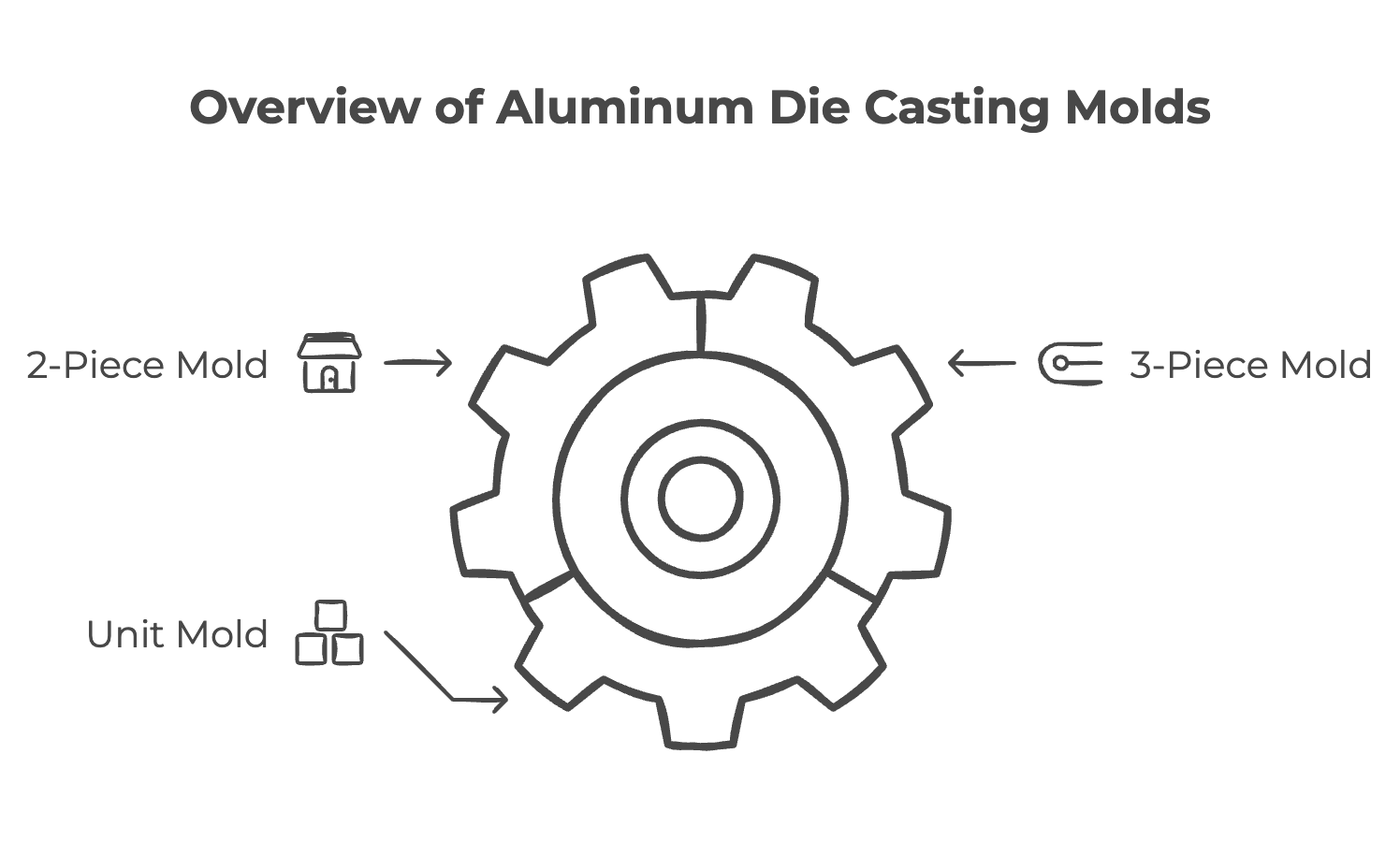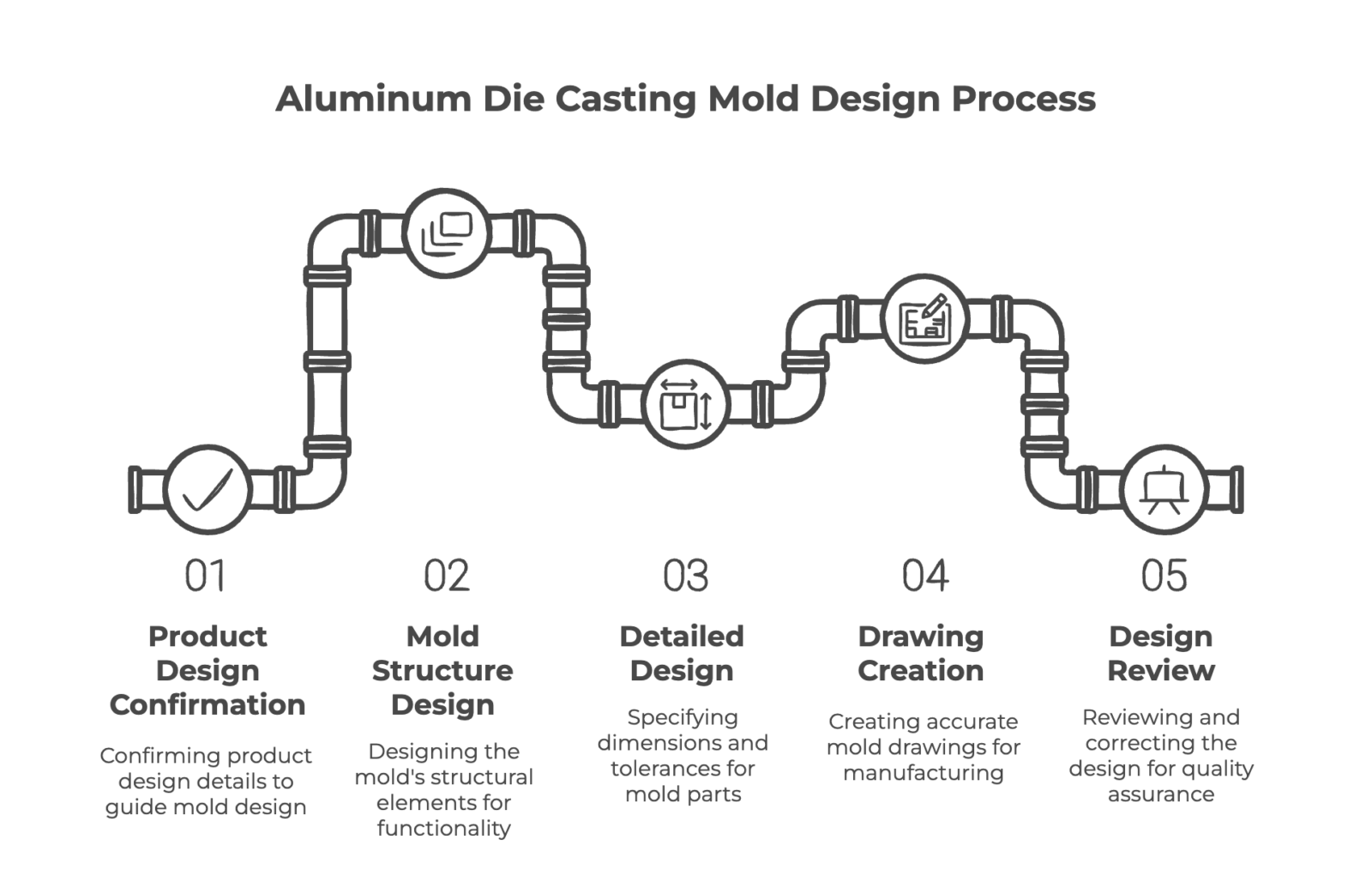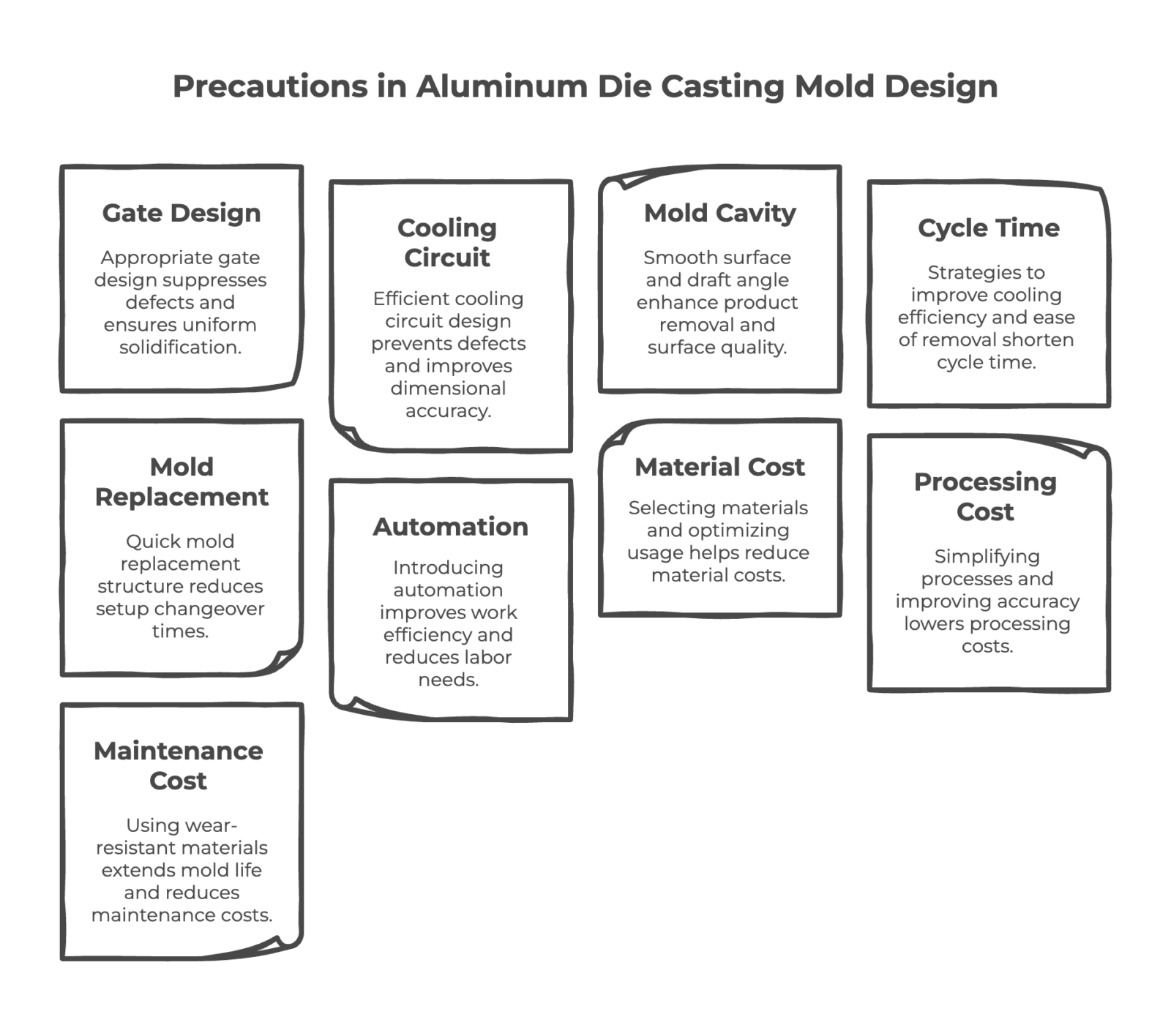◆Table of contents
ToggleIntroduction
Aluminum die casting is an excellent technology that can produce parts with complex shapes in high precision and in large quantities. And an important factor that affects its quality is the “aluminum mold.” Depending on the mold design, the product’s accuracy, strength, lifespan, and even production costs can vary significantly.
This article will explain in detail the points for achieving high precision and long life in aluminum mold design, along with design know-how. By providing comprehensive coverage of basic mold knowledge, design processes, precautions, and the latest technologies, we aim to provide information that will help improve design quality.
Basics of Aluminum Die Casting Mold Design
Role and Importance of Aluminum Die Casting Molds
Aluminum die casting is a manufacturing process that molds high-precision products by pouring molten aluminum alloy into a mold. Among them, the mold plays an important role in determining the product’s shape, dimensional accuracy, and surface quality. The quality of the mold design directly affects product quality, productivity, and cost, making it a very important process in aluminum die casting.
Types of Aluminum Die Casting Molds
There are mainly three types of aluminum die casting molds:
- 2-Piece Mold: The most common type of mold, consisting of two parts: a fixed side and a movable side. It is applied to a wide range of products because of its simple structure and relatively low manufacturing cost.
- 3-Piece Mold: A mold consisting of three parts: a fixed side, a movable side, and an insert. Used when molding undercut shapes or products with complex shapes.
- Unit Mold: A mold that can handle a variety of products by combining standardized parts. Easy mold replacement contributes to shortening setup changeover times.
Knowledge Required for Aluminum Die Casting Mold Design
A wide range of knowledge is required for the design of aluminum die casting molds, including:
- Mechanics of Materials: Knowledge necessary to analyze stress, strain, deformation, etc. applied to the mold and ensure strength and durability.
- Thermodynamics: Knowledge necessary to understand the solidification process of molten aluminum, the cooling process of the mold, etc., and to perform appropriate temperature control.
- Fluid Dynamics: Knowledge necessary to analyze the flow of molten aluminum, the flow of air in the mold, etc., and to suppress the occurrence of filling defects and blowholes.
- Material Knowledge: It is necessary to understand the properties of aluminum alloys, the properties of mold materials, the effects of heat treatment, etc.
By comprehensively utilizing this knowledge, high-precision and long-life aluminum die casting molds can be designed.
Aluminum Die Casting Mold Design Process
Aluminum die casting mold design is an important process that greatly affects product quality, productivity, and cost. By properly managing the design process, high-precision and long-life molds can be manufactured.
Product Design Confirmation
Before starting mold design, it is necessary to confirm the product design in detail. By understanding the product’s shape, dimensions, tolerances, materials, functions, etc., and grasping the design intent, the points to be reflected in the mold design are clarified.
Mold Structure Design
After confirming the product design, the mold structure design begins. At this stage, the following elements are determined:
- Mold Parting Surface: Set the parting surface at an appropriate position to make it easy to remove the product from the mold.
- Draft Angle: Provide the necessary draft angle to smoothly remove the product from the mold.
- Number of Cavities: Depending on the production volume, multiple cavities can be provided in one mold.
- Gate Position: Determine the position of the gate through which molten aluminum is poured into the cavity.
- Runner Shape: Design the flow path shape of molten aluminum from the gate to the cavity.
- Cooling Circuit: Design a cooling circuit to efficiently cool the mold.
Detailed Design
After designing the mold structure, the detailed design begins. At this stage, the dimensions, shapes, tolerances, etc. of each part of the mold are determined. It is also necessary to consider processing methods, accuracy, surface treatment, etc.
Drawing Creation
Once the detailed design is complete, create mold drawings based on the design content. Since the drawing serves as an instruction manual for mold manufacturing, it must be created accurately. Drawing creation must comply with standard specifications such as JIS.
Design Review
After creating the drawings, the design content is reviewed by the parties concerned. In the review, design errors and areas for improvement are checked, and corrections are made if there are any problems. Design review is an important process to ensure the quality of mold design.
Precautions in Aluminum Die Casting Mold Design
Aluminum die casting mold design is an important process that greatly affects product quality, productivity, and cost. By considering various precautions at the design stage, high-quality and long-life molds can be manufactured, and efficient production can be achieved.
Design for Product Quality Improvement
For product quality improvement, it is important to consider the flow of molten aluminum and the solidification process in the design.
- Appropriate Gate Design: The gate is the part through which molten aluminum is poured into the cavity, and the filling state and flow velocity change depending on its position, size, and shape. By performing appropriate gate design, the occurrence of filling defects and blowholes can be suppressed, and uniform solidification can be realized.
- Cooling Circuit Design: The cooling circuit is an important factor for efficiently cooling the mold and controlling the solidification rate of the product. By performing appropriate cooling circuit design, defects such as deformation and sink marks can be prevented, and dimensional accuracy can be improved.
- Mold Cavity Design: The mold cavity is the part that determines the shape of the product. By providing a smooth surface and an appropriate draft angle, product removal can be facilitated and surface quality can be improved.
Design to Improve Productivity
To improve productivity, it is important to shorten cycle time and facilitate mold replacement.
- Cycle Time Reduction: Cycle time can be shortened by devising ways to improve mold cooling efficiency and make the structure easy to remove.
- Facilitation of Mold Replacement: Making the structure such that mold replacement can be performed quickly leads to shortening setup changeover times.
- Automation and Labor Saving: Work efficiency can be improved by introducing automation equipment and robots.
Design to Reduce Manufacturing Costs
To reduce manufacturing costs, it is necessary to consider material costs, processing costs, maintenance costs, etc.
- Material Cost Reduction: Material costs can be reduced by selecting mold materials and optimizing usage.
- Processing Cost Reduction: Processing costs can be reduced by simplifying the processing process and improving processing accuracy.
- Maintenance Cost Reduction: Mold life is extended by using materials with excellent wear resistance and corrosion resistance.
Latest Technologies in Aluminum Die Casting Mold Design
In the field of aluminum die casting mold design, various latest technologies have been introduced in recent years, promoting design efficiency, high precision, and mold longevity.
Use of 3D Printing Technology
3D printing technology is a technology that directly manufactures shaped objects from CAD data. It enables the manufacture of molds with complex shapes that were difficult with conventional machining in a short period.
Molds manufactured with 3D printers can freely design cooling water channels, contributing to improved cooling efficiency, and consequently, shortened cycle times and improved product quality. It also increases the degree of freedom in mold design, enabling the manufacture of products with more complex shapes.
Use of Advanced Simulation Technology
Computer simulation technology has become an indispensable tool for optimizing mold design.
- Flow Analysis: By simulating the flow state of molten aluminum, it is possible to predict the occurrence of filling defects and blowholes, and optimize gate positions and runner shapes.
- Thermal Analysis: By simulating the temperature distribution of the mold, it is possible to predict cooling efficiency and solidification processes, and optimize the design of cooling circuits and the selection of mold materials.
- Stress Analysis: By simulating the stress and strain applied to the mold, it is possible to predict strength insufficiency and deformation, and optimize the design of the mold structure.
Use of Digital Twin Technology
Digital twin technology is a technology that reproduces real-world molds in virtual space. By reflecting the mold’s operating data obtained from sensors etc. in the virtual space, the mold’s condition can be monitored in real time.
By utilizing digital twins, it is possible to detect mold abnormalities early and perform predictive maintenance to prevent failures. It also helps in predicting mold life and improving performance.
Use of AI and Machine Learning
AI and machine learning are technologies that learn from large amounts of data and find regularities and patterns in them. In the field of mold design, the use of AI and machine learning is promoting design automation and optimization.
For example, systems that automatically generate optimal mold designs by having AI learn past design data and simulation results are being developed. AI-powered mold design support tools have also appeared, contributing to design efficiency.
Summary
Aluminum mold design is an important process that affects the quality, productivity, and cost of aluminum die-cast products. By understanding the basic knowledge of design and implementing appropriate design processes, high-precision and long-life molds can be manufactured.
Let’s pursue further quality improvement, productivity improvement, and cost reduction by introducing the latest technology and utilizing design know-how.



